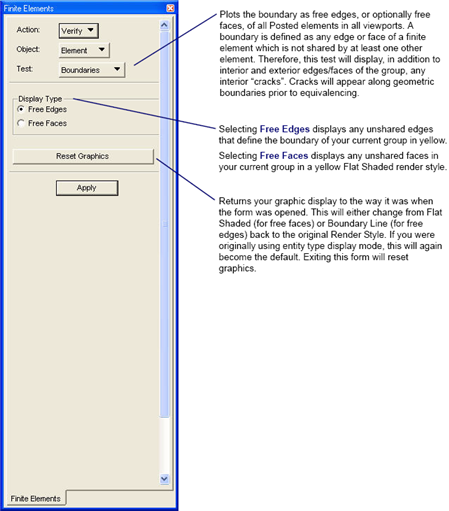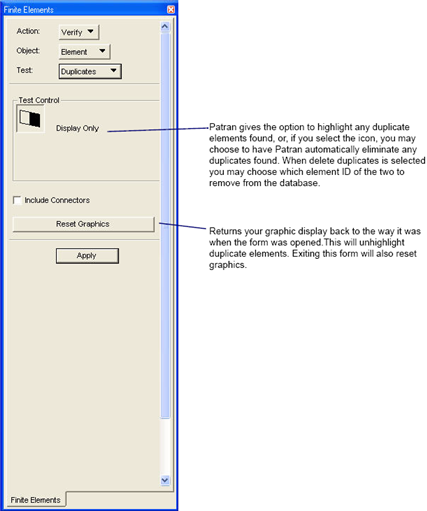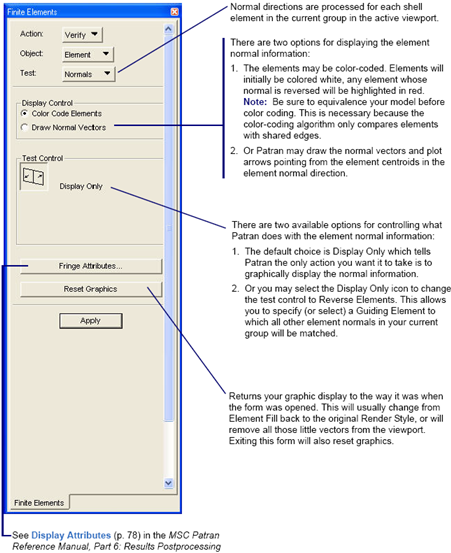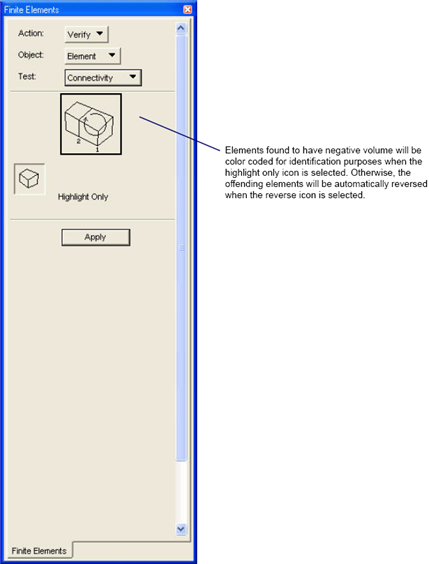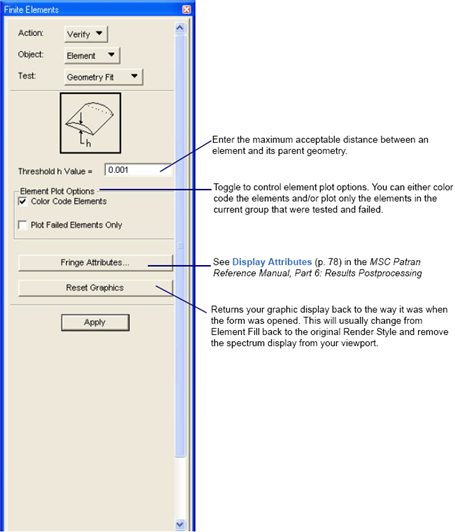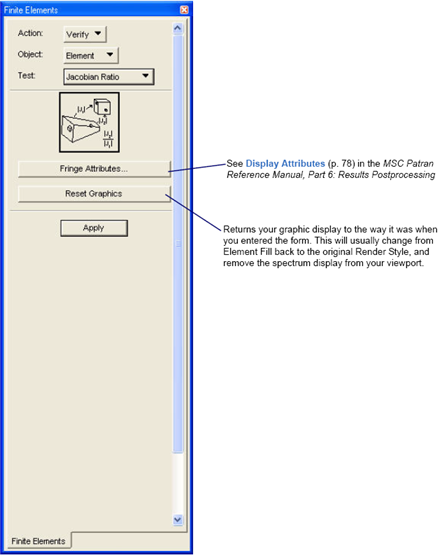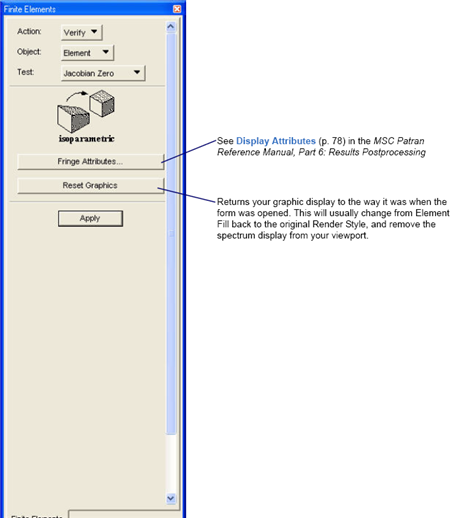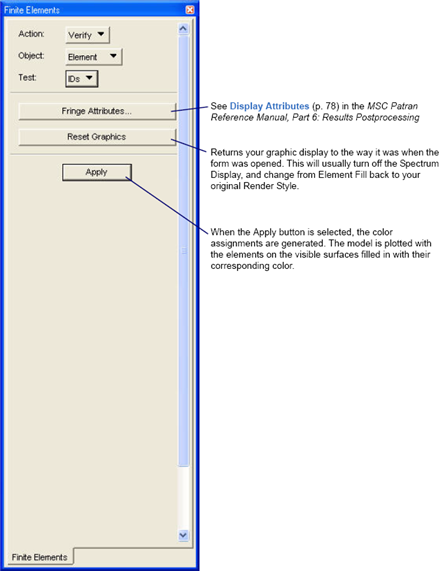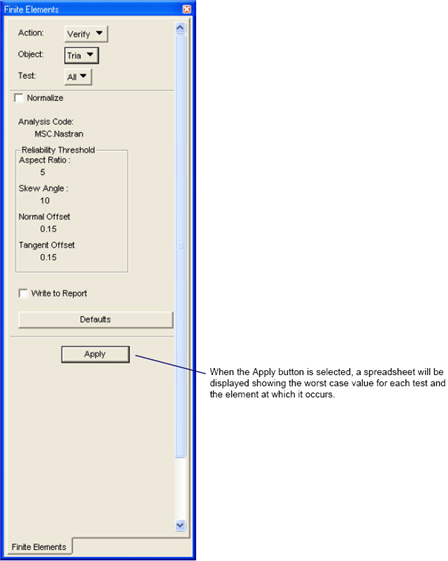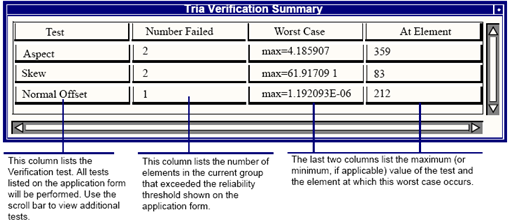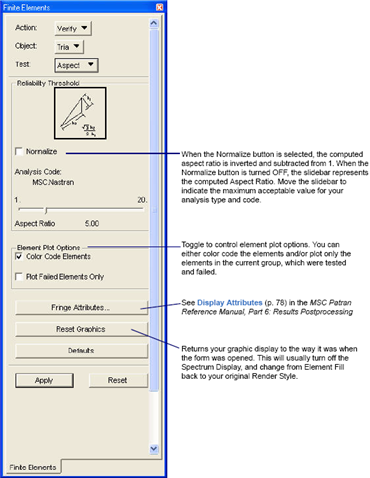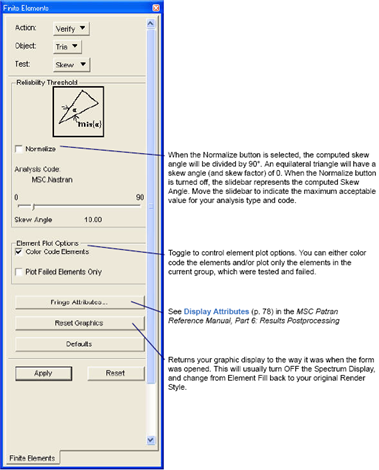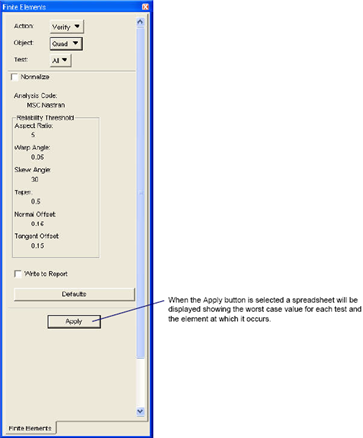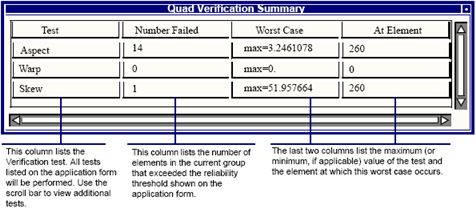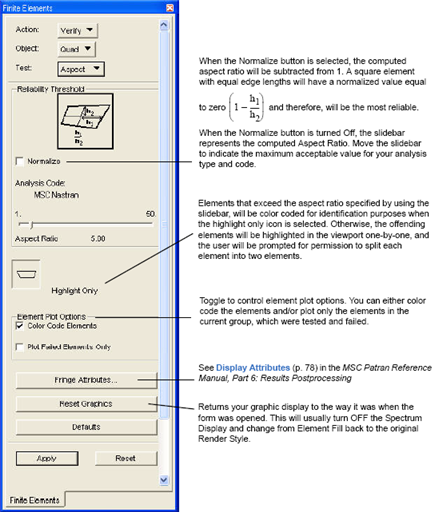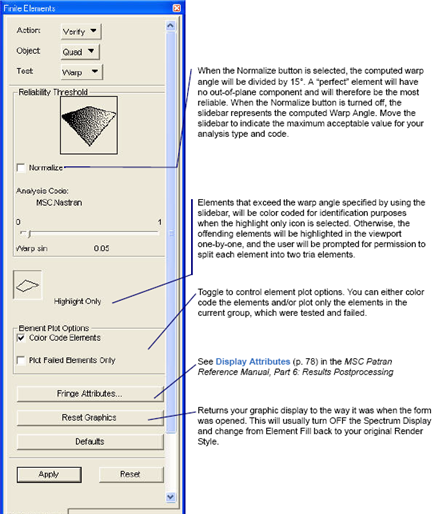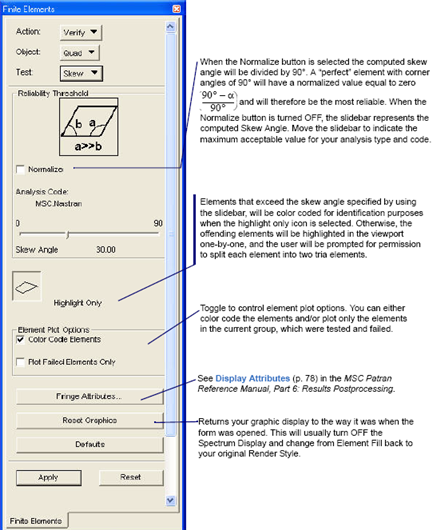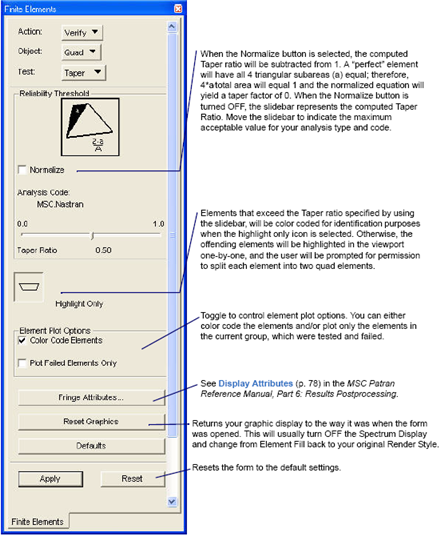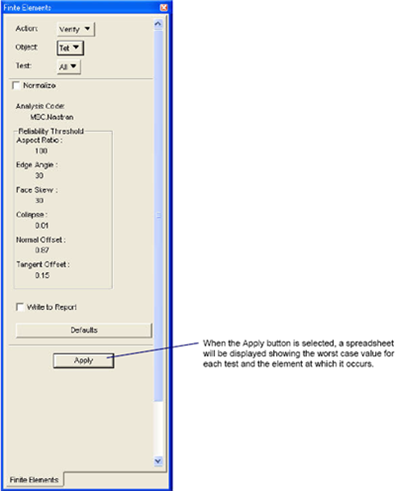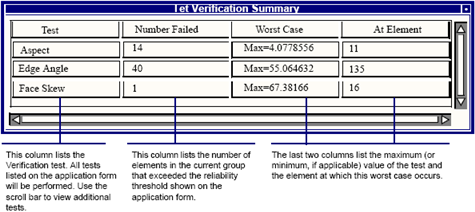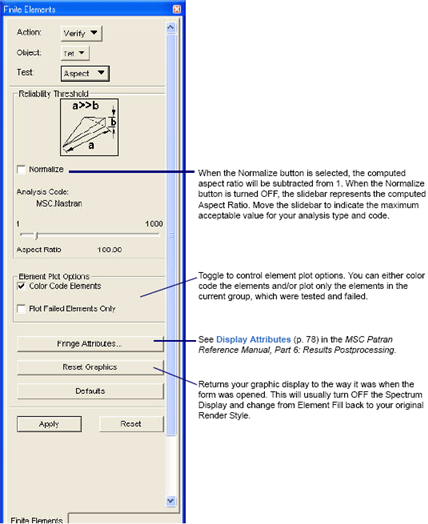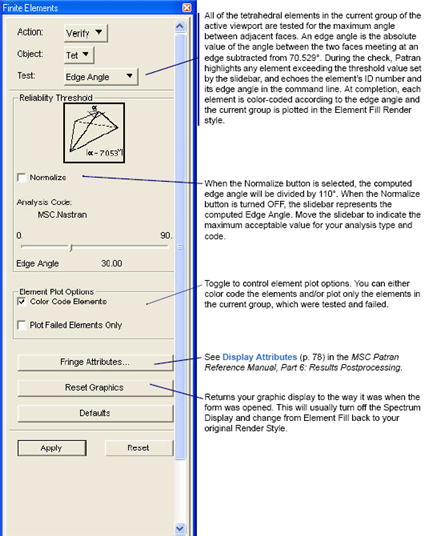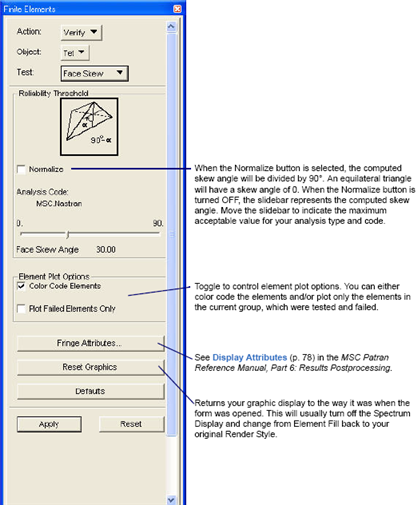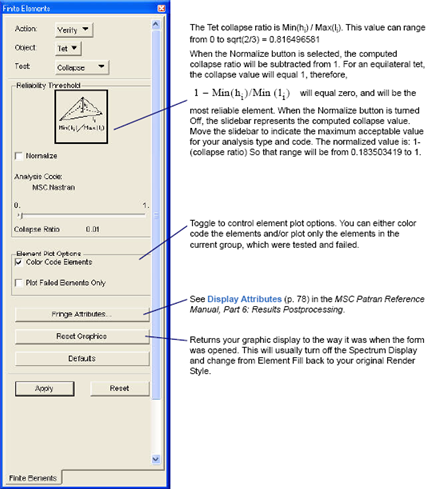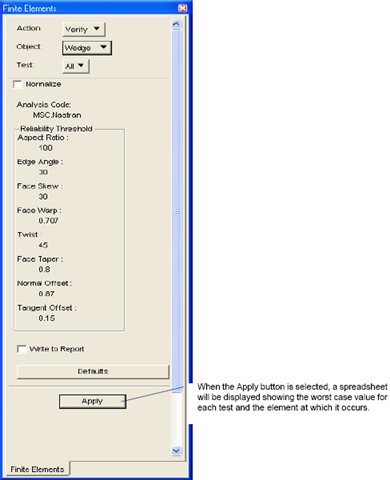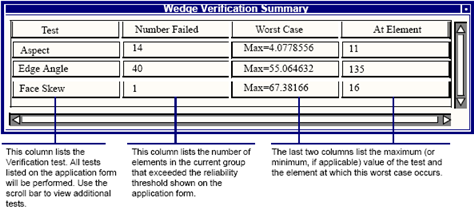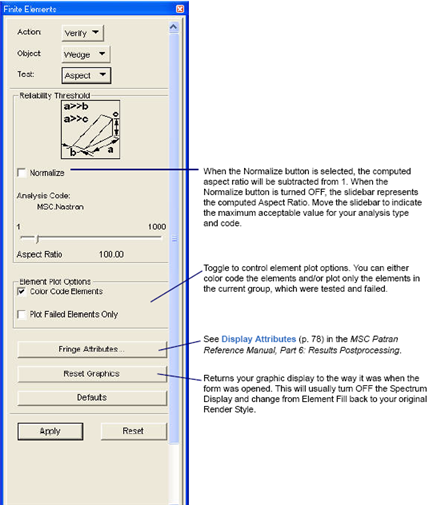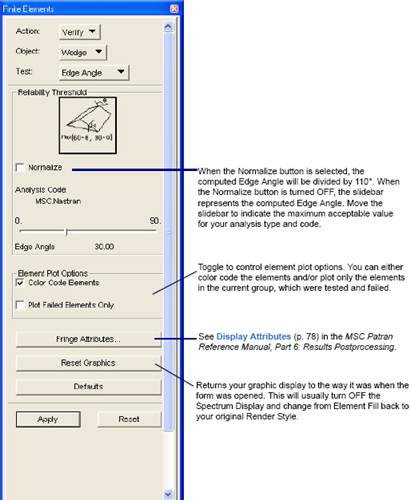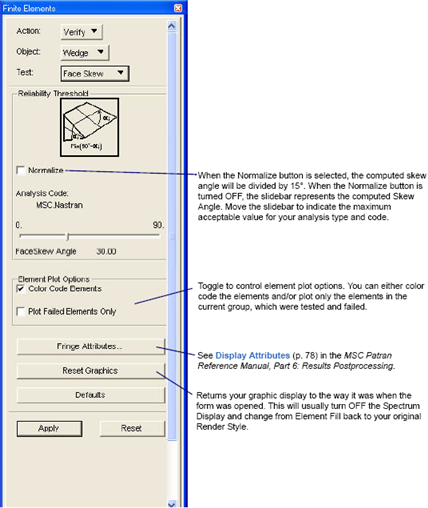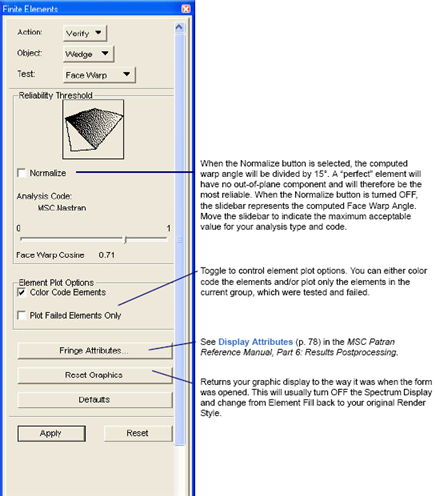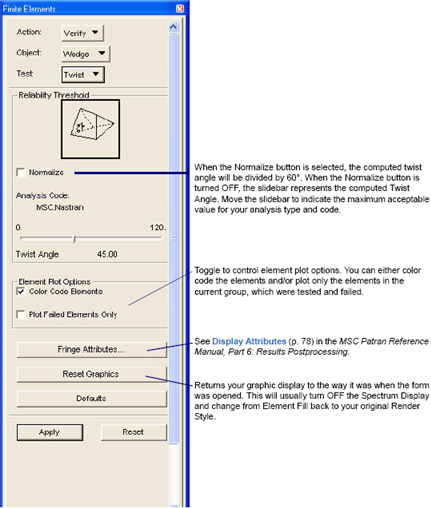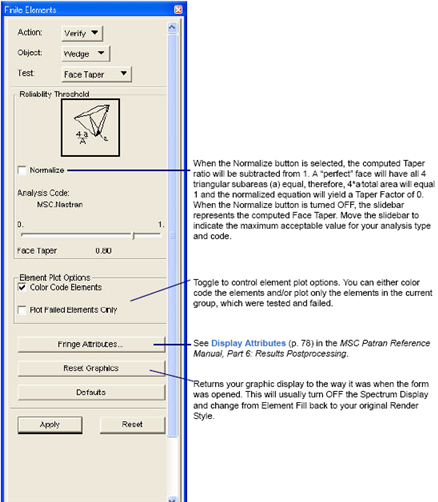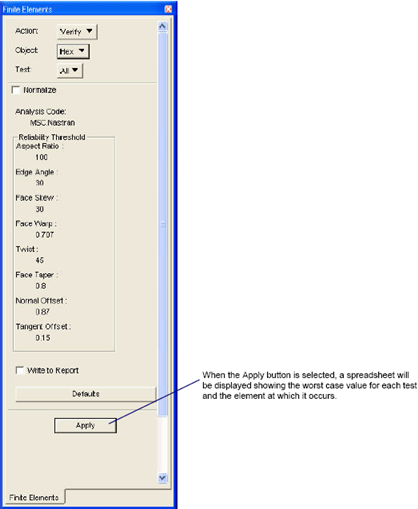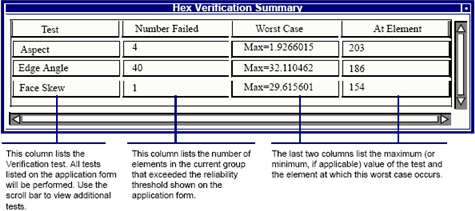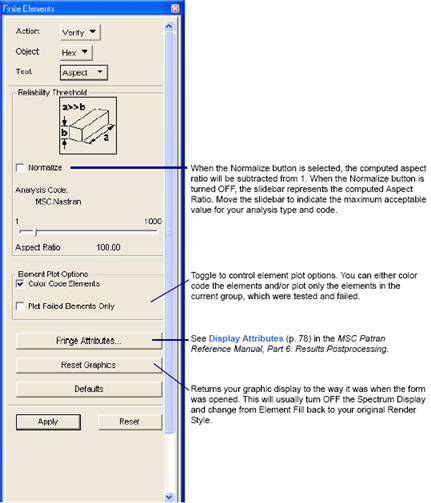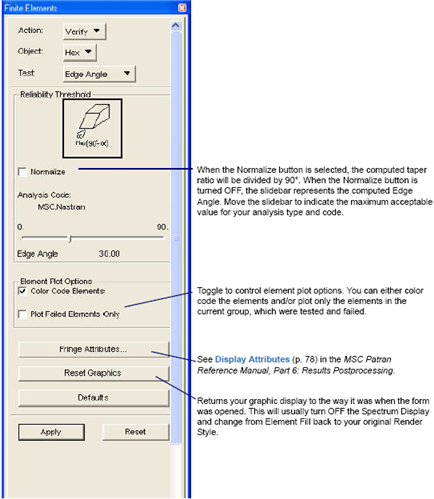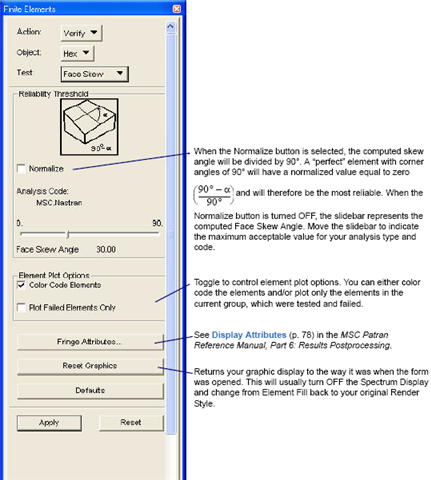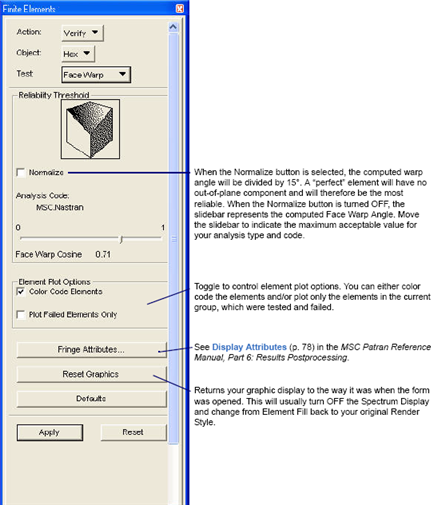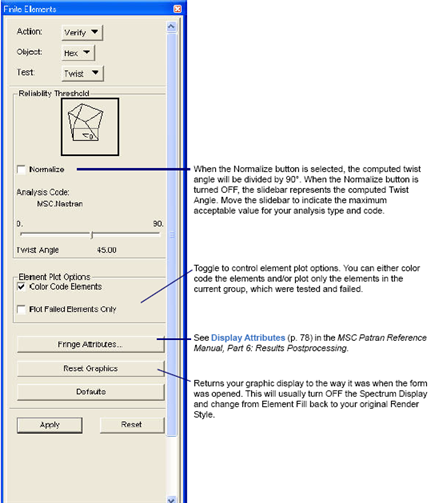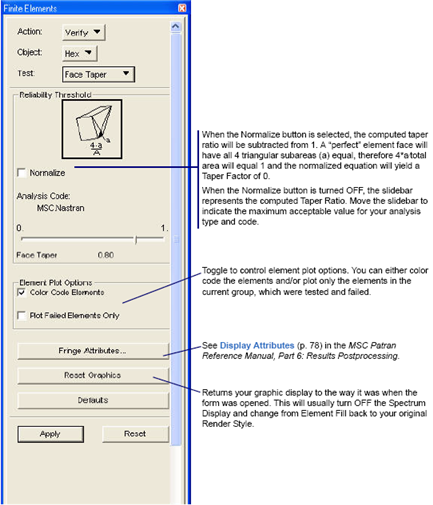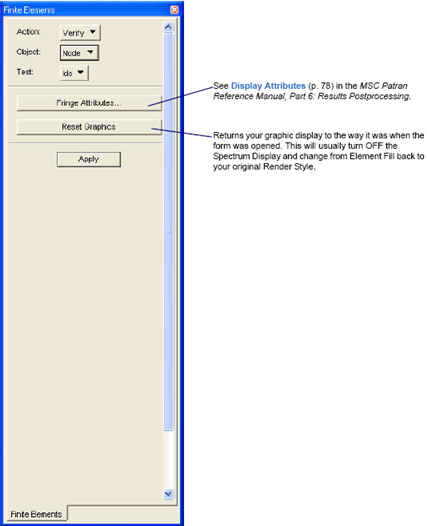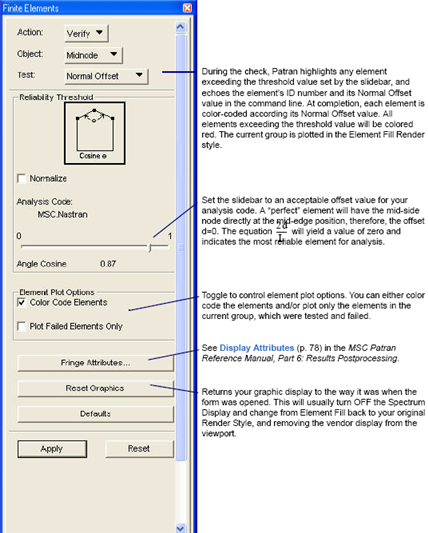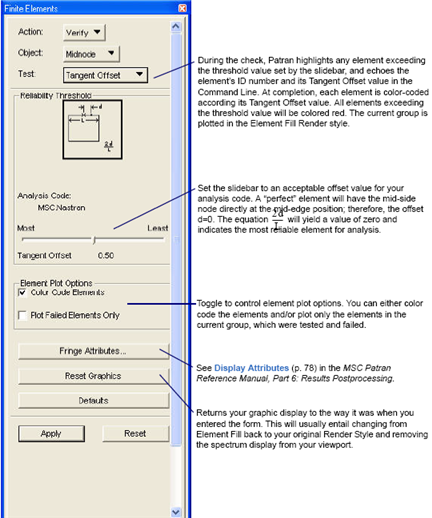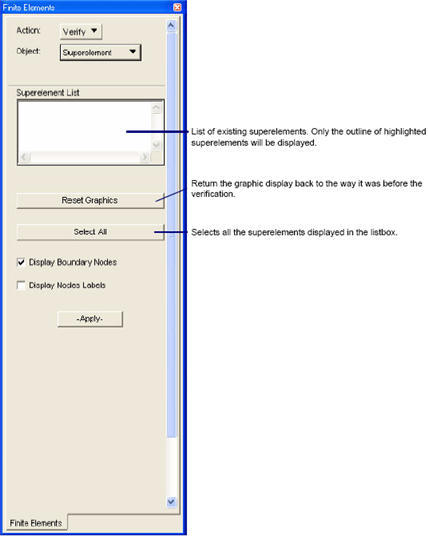XXXXXXXXXXXXXXXXXXXXXXXXXXXXXXXXXXXXXXXXXXXXXXXXXXXXXXXXXXXXXXXXXXXXXXXXXXXXXXXXXXXXXXXXXXXXXXXXXXXXXXXXXXXXXXXXXXXXXXXXXXXXXXXXXXXXXXXXXXXXXXXXXXXXXXXX''"> Verify Forms
When Verify is the selected Action the following options are available.
Object | Test | Description |
Element | | Plots the free edges or faces of finite elements. |
| Checks elements for identical corner (or end) nodes. |
| Compare adjacent shell normals. |
| Check solid elements for proper connectivity using a volume calculation. |
| Checks fit error distances between elements and their parent geometry. |
| Reports the maximum variation of the determinant of the Jacobian over each element. |
| Reports the minimum determinant of the Jacobian for each element. |
| Assigns color to the Finite Elements based on the Element ID number. |
Tria | | Tests tria elements for each of the tria verification tests. Reports the worst case for each test and the element at which it occurs. |
| Measures length to width ratio of tria elements. |
| Tests tria elements for angular deviation using an edge bisector method. |
Quad | | Tests quad elements for each of the quad verification tests. Reports the worst case for each test and the element at which it occurs. |
| Measures length to width ratio of quad elements. |
| Tests quad elements for deviation out of plane. |
| Tests quad elements for angular deviation from a rectangular shape using an edge bisector method. |
| Tests quad elements for geometric deviation from a rectangular shape. |
Tet | | Tests tet elements for each of the tet verification tests. Reports the worst case for each test and the element at which it occurs. |
| Compares ratio of height to square root of opposing face area of tet elements. |
| Calculates the maximum deviation angle between adjacent faces of tet elements. |
| Tests each face of tet elements for angular deviation using an edge bisector method. |
| Tests tet elements for near zero volume. |
Wedge | | Tests wedge elements for each of the wedge verification tests. Reports the worst case for each test and the element at which it occurs. |
| Compares the maximum ratio of the height of the triangular sides to the distance between them for each wedge element. |
| Calculates the angular deviation between adjacent faces of wedge elements. |
| Tests each face of wedge elements for angular deviation using an edge bisector method. |
| Tests each quad face of wedge elements for deviation out of plane. |
| Computes a twist angle between the two triangular faces of wedge elements. |
| Tests each quad face of wedge elements for geometric deviation from a rectangular shape. |
Hex | | Tests hex elements for each of the hex verification tests. Reports the worst case for each test and the element at which it occurs. |
| Calculates the ratio of the maximum to minimum distance between opposing faces for each Hex element. |
| Calculates the angular deviation between adjacent faces of hex elements. |
| Calculates the skew angle for each face of a hex element and reports the maximum. |
| Calculates the deviation out of plane for each element face. |
| Computes twist between the opposing faces of hex elements. |
| Tests each Hex element for geometric deviation from a rectangular shape. |
Node | | Computes contour lines based on the ID numbers of the Nodes. |
Midnode | | Calculates the ratio between the perpendicular offset of the midside node and the element edge length. |
| | Measures the offset from the center of the element edge to the midside node. Calculates the ratio of this offset to the element edge length. |
| | Displays superelement’s boundaries with or without the boundary nodes. |
Verify - Element (Boundaries)
Note: | If you are in entity type display mode when you start boundary verification, Patran will temporarily enter group display mode to display the group boundaries. |
Verify - Element (Duplicates)
Elements in the entire model are checked for identical corner (or end) nodes.
Verify - Element (Normals)
Figure 11‑1
Verify - Element (Connectivity)
All solid elements in the current group in the active viewport are checked for proper connectivity using a volume calculation.
More Help:
Verify - Element (Geometry Fit)
All elements in the current group in the active viewport are checked for maximum distance between the element and the parent geometry.
Note: | Linear elements such as Bar/2, Quad/4, and Hex/8 are evaluated at one point per bar or element face. Quadratic elements such as Bar/3, Quad/8, and Hex/20 are evaluated at two points per bar or four points per element face. Cubic elements such as Bar/4, Quad/12, and Hex/32 are evaluated at three points per bar or nine points per element face. |
Verify - Element (Jacobian Ratio)
The ratio of the maximum determinant of the Jacobian to the minimum determinant of the Jacobian is calculated for each element in the current group in the active viewport. This element shape test can be used to identify elements with interior corner angles far from 90 degrees or high order elements with misplaced midside nodes. A ratio close or equal to 1.0 is desired.
Note: | The minimum and maximum ratios and the associated elements are echoed in the command line. Elements in the current group are color-coded according to the value of the Jacobian ratio and will be plotted in the Element Fill render style. |
Verify - Element (Jacobian Zero)
The determinant of the Jacobian (J) is calculated at all integration points for each element in the current group in the active viewport. The minimum value for each element is determined. This element shape test can be used to identify incorrectly shaped elements. A well-formed element will have J positive at each Gauss point and not greatly different from the value of J at other Gauss points. J approaches zero as an element vertex angle approaches 180 degrees.
Note: | The minimum and maximum value and the associated elements are echoed in the command line. Elements in the current group are color-coded according to the value of the determinant of the Jacobian and will be plotted in the Element Fill render style. |
Verify - Element (IDs)
Each element in the current group in the active viewport is assigned a color based on its ID number.
Verify - Tria (All)
Each tria element in the current group is tested for each of the tria verification tests.
Verify - Tria (All) Spreadsheet
Verify - Tria (Aspect)
All of the tria elements in the current group of the active viewport are tested for length to width ratio.
More Help:
Verify - Tria (Skew)
Each tria element in the current group of the active viewport is tested for skew. The skew angle is obtained as described in
Theory.
More Help:
Verify - Quad (All)
Each quad element in the current group of the active viewport is tested for each of the quad verification tests.
More Help:
Verify - Quad (All) Spreadsheet
Verify - Quad (Aspect)
All of the quads in the current group, in the active viewport, are tested for length to width ratio. During the check, if an element exceeds the threshold value set by the slidebar, it is highlighted and Patran echoes the element’s ID number, and its aspect value in the command line. At completion, each element is color-coded according to the value computed for its aspect value, and the current group is plotted in the Element Fill Render style.
More Help:
How Aspect Ratio is computed
page 266Verify - Quad (Warp)
Each quad element in the current group of the active viewport is tested for warp. The warp angle is obtained as described in
Theory. During the check, Patran highlights any element exceeding the threshold value set by the slidebar, and echoes the element’s ID number and its warp value in the command line. At completion, each element is color-coded according to the value computed for its warp value and the current group is plotted in the Element Fill Render style.
More Help:
Verify - Quad (Skew)
Each quad element in the current group in the active viewport is tested for skew. The skew angle is obtained as described in
Theory. Prior to testing for skew, each element is checked for convexity. If any element fails the convexity, test a warning message will be issued. Processing will continue on to the next element.
More Help:
Verify - Quad (Taper)
Each quad element in the current group in the active viewport is tested for taper. The taper ratio is obtained as described in
Theory.
More Help:
Verify - Tet (All)
Each Tetrahedral element in the current group is tested for each of the Tet verification tests.
More Help:
Verify - Tet (All) Spreadsheet
Verify - Tet (Aspect)
All of the Tets in the current group are tested for the ratio of height to square root of opposing face area. During the check, Patran highlights any element exceeding the threshold value set by the slidebar, and echoes the element’s ID number and its aspect ratio in the command line. At completion, each element is color-coded according to the value computed for its aspect ratio and the current group is plotted in the Element Fill Render style.
More Help:
Verify - Tet (Edge Angle)
More Help:
How Edge Angle is computed
page 272Verify - Tet (Face Skew)
Each face of each tetrahedral element in the current group is tested for skew as if it were a Tria element. The skew angle is obtained as described in
Theory. During the check, Patran highlights any element exceeding the threshold value set by the slidebar, and echoes the element’s ID number and its maximum skew angle in the command line. At completion, each element is color-coded according to the value computed for its skew angle and the current group is plotted in the Element Fill Render style.
Verify - Tet (Collapse)
All of the tetrahedral elements in the current group are tested for volume. The collapse value is obtained as described in
Theory. During the check, Patran highlights any element exceeding the threshold value set by the slidebar, and echoes the element’s ID number and its collapse value in the command line. At completion, each element is color-coded according to the collapse value and the current group is plotted in the Element Fill Render style.
More Help:
Verify - Wedge (All)
Each wedge element in the current group of the active viewport is tested for each of the wedge verification tests.
More Help:
Verify - Wedge (All) Spreadsheet
Verify - Wedge (Aspect)
All of the wedge elements in the current group are tested for length to width ratio. During the check, if an element exceeds the threshold value set by the slidebar, it is highlighted and Patran echoes the element’s ID number and its aspect value in the command line. At completion, each element is color-coded according to the value computed for its aspect value and the current group is plotted in the Element Fill Render style.
More Help:
Verify - Wedge (Edge Angle)
The maximum edge angle is calculated for each wedge element in the current group of the active viewport. Edge angle is obtained as described in
Theory. During the check, Patran highlights any element exceeding the threshold value set by the slidebar, and echoes the element’s ID number and its maximum edge angle in the command line. At completion, each element is color-coded according to the value computed for its edge angle and the current group is plotted in the Element Fill Render style.
More Help:
Verify - Wedge (Face Skew)
Each face of each wedge element in the current group is tested for skew as if it were a quad or tria element. The skew angle is obtained as described in
Theory. During the check, Patran highlights any element exceeding the threshold value set by the slidebar, and echoes the element’s ID number and its maximum skew angle in the command line. At completion, each element is color-coded according to the value computed for its skew angle and the current group is plotted in the Element Fill Render style.
Verify - Wedge (Face Warp)
Each quad face of each wedge element in the current group is tested for warp as if it were a quad. The warp angle is obtained as described in
Theory. During the check, Patran highlights any element exceeding the threshold value set by the slidebar, and echoes the element’s ID number and its warp value in the command line. At completion, each element is color-coded according to the value computed for its warp value and the current group is plotted in the Element Fill Render style.
More Help:
Verify - Wedge (Twist)
Each wedge element in the current group is tested for a twist angle computed between its two triangular faces. Twist is obtained as described in
Theory. During the check, Patran highlights any element exceeding the threshold value set by the slidebar, and echoes the element’s ID number and its maximum twist in the command line. At completion, each element is color-coded according to the value computed for its twist and the current group is plotted in the Element Fill Render style.
More Help:
Verify - Wedge (Face Taper)
Each quad face of each wedge element in the current group of the active viewport is tested for taper as if it were a Quad element. Taper is obtained as described in
Theory. During the check, Patran highlights any element exceeding the threshold value set by the slidebar, and echoes the element’s ID number and its maximum taper in the command line. At completion, each element is color-coded according to the value computed for its taper and the current group is plotted in the Element Fill Render style.
More Help:
Verify - Hex (All)
Each hex element in the current group of the active viewport is tested for each of the hex verification tests.
More Help:
Verify - Hex (All) Spreadsheet
Verify - Hex (Aspect)
All of the hex elements in the current group in the active viewport are tested for length to width ratio. During the check, if an element exceeds the threshold value set by the slidebar, it is highlighted and Patran echoes the element’s ID number and its aspect value in the command line. At completion, each element is color-coded according to the value computed for its aspect value and the current group is plotted in the Element Fill Render style.
More Help:
Verify - Hex (Edge Angle)
The maximum edge angle is calculated for each hex element in the current group. Edge angle is obtained as described in
Theory. During the check, Patran highlights any element exceeding the threshold value set by the slidebar, and echoes the element’s ID number and its maximum edge angle in the command line. At completion, each element is color-coded according to the value computed for its edge angle and the current group is plotted in the Element Fill Render style.
Verify - Hex (Face Skew)
Each face of each hex element in the current group is tested for skew as if it were a quad element. The skew angle is obtained as described in
Theory. Prior to testing for skew, each element face is checked for convexity. If any face fails the convexity test, a warning message will be issued. Processing will continue on to the next element face. During the check, Patran highlights any element exceeding the threshold value set by the slidebar, and echoes the element’s ID number and its maximum skew angle in the command line. At completion, each element is color-coded according to the value computed for its skew angle and the current group is plotted in the Element Fill Render style.
More Help:
Verify - Hex (Face Warp)
Each face of each hex element in the current group is tested for warp as if it were a quad. The warp angle is obtained as described in
Theory. During the check, Patran highlights any element exceeding the threshold value set by the slidebar, and echoes the element’s ID number and its warp value in the command line. At completion, each element is color-coded according to the value computed for its warp value and the current group is plotted in the Element Fill Render style.
More Help:
Verify - Hex (Twist)
Each hex element in the current group is tested for maximum twist angle. Twist is obtained as described in
Theory. During the check, Patran highlights any element exceeding the threshold value set by the slidebar, and echoes the element’s ID number and its maximum twist in the command line. At completion, each element is color-coded according to the value computed for its twist and the current group is plotted in the Element Fill Render style.
More Help:
Verify - Hex (Face Taper)
Each face of each hex element in the current group is tested for taper as if it were a quad element. Taper is obtained as described in
Theory. During the check, Patran highlights any element exceeding the threshold value set by the slidebar, and echoes the element’s ID number and its maximum taper in the command line. At completion, each element is color-coded according to the value computed for its taper and the current group is plotted in the Element Fill Render style.
Verify - Node (IDs)
Fringe plot based on node ID of nodes in the current group is generated. This display is helpful to check whether the node numbering has been optimized for bandwidth efficiency.
Verify - Midnode (Normal Offset)
All quadratic order elements (those with mid-side nodes) in the current group are tested for deviation of the mid-side node from the mid-node position for an element with no curvature. The offset distance is measured perpendicular to a line that is the shortest distance between the corner nodes of that edge.
Verify - Midnode (Tangent Offset)
All quadratic order elements (those with mid-side nodes) in the current group in the active viewport are tested for deviation of the mid-side node from the mid-edge position of the element. The offset distance is measured along a line that is the shortest distance between the corner nodes of that edge.
Superelement
This form verifies the selected superelements for any inconsistencies. Note that this is only available for the MSC Nastran analysis preference.
